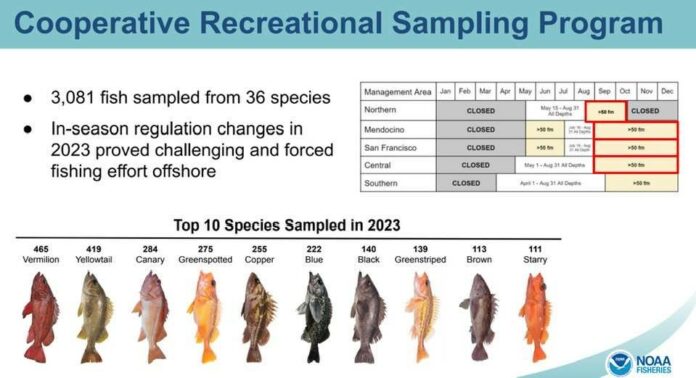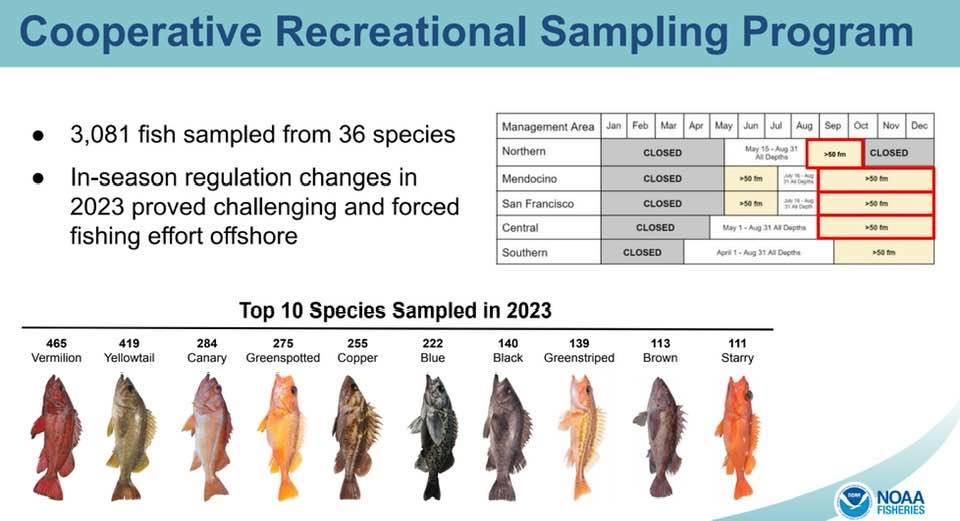

BY DAVE HURLEY
WON Staff Writer
SANTA CRUZ – The northern California commercial and recreational rockfish industry was turned on its head last September 1 when all nearshore fisheries were closed due to the scarcity of quillback rockfish, leaving the only option for recreational rock fishing deeper than 50 fathoms until the end of the season. Many in the industry were caught unaware of the scarcity of the quillback, and most of the resulting outcry was based upon the accuracy of the stock assessments. The Cooperative Recreational Sampling Program is a joint venture between scientists from the National Oceanic and Atmospheric Administration Fisheries Division (NOAA), California university graduate programs involved with the California Collaborative Fisheries Research Program (CCFRP), and recreational charter boat operators working out of every California port. Although charter boat captains are, in most cases, not trained scientists, they are a deep source of knowledge of local reefs, rockfish species, and trends and tendencies. Combining the expertise of scientists along with the experience base of the captains provides data not previously available. The sampling program is very timely in that there is a lack of biological data on the life history parameters of nearshore groundfish species across California.
The sampling program has laboratories in both southern and northern California, under the direction of Dr. Melissa Monk of the National Marine Fisheries Service (NMFS) out of the NOAA Laboratory in Santa Cruz. Rachel Brooks, Fisheries Biologist and Data Analyst, operates out of the NOAA Laboratory in La Jolla for southern California. The pilot for the sampling program took place in 2023 with seven vessels specifically for the two most vulnerable species, quillback and copper. According to Dr. Monk, “We were able to work with five vessels in southern California as well as in Santa Cruz and Emeryville, eventually sampling 762 copper and 133 quillbacks, training the crew to measure the fish to the millimeter, fillet around the gut cavity so the sex can be determined, and then freeze the samples before sending them to the laboratory for analysis. We expanded the program in 2023 to 18 vessels throughout the state, and we are sampling all nearshore rockfish species, excluding the shelf and slope rockfish species of Boccaccio, widow, and chili pepper. The deckhands on the charter boats are compensated for processing the fish, and when 50 fish are collected, they are either sent via postal service or pick up for analysis by university graduate students involved with CCFRP. We are building a library of data across the California coast to be included in the stock assessments by the NMFS. The program has been funded for three years by the Ocean Protection Council with some funding dedicated to CCFRP graduate students. CCFRP is the gold standard in citizen/scientific groundfish data collection, and our sampling is another source of real-time data. We are really looking forward to a more complete sampling this year since the last three months of 2023 were limited due to the shallow water restriction. We are appreciative of our charter boat partners and their dedication to the data collection process.”
No one – government agencies, commercial fishermen, or recreational charter boat captains ever again want to be the position of closing a fishery mid-season. NOAA’s Cooperative Recreational Sampling Program is a viable method of science and the fishing industry to work together for the benefit of all California’s anglers.



